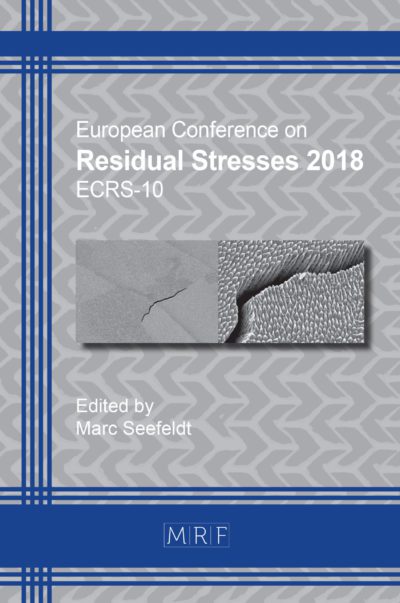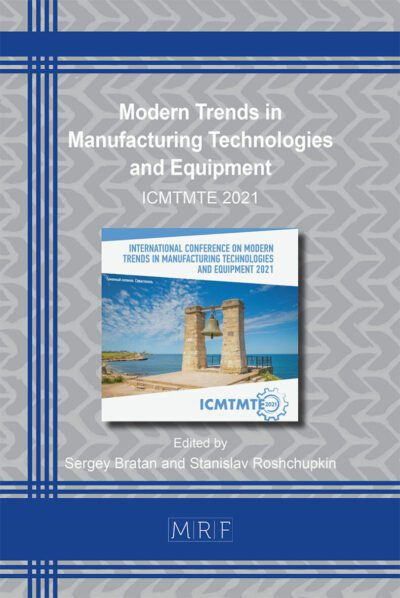Porosity analysis of L-PBF manufactured AZ91D components
Lennart Grüger, Joanna Szyndler, Felix Jensch, Sebastian Härtel
Abstract. Several materials for joint replacement parts approved in medical technology are being investigated. Magnesium alloys are very suitable for implants due to the similar strength properties between magnesium alloys and human bone. Therefore, the present work aims to examine the parameters for producing the magnesium alloy AZ91D. For this purpose, 16 samples were manufactured with varying laser power and exposure speed and examined using µCT analyses. As a result, densities between 99.56 and 95.21 percent were achieved. The samples with the lowest density were subjected to a HIP process to increase the relative density. However, a further µCT analysis revealed only minor positive effects of the HIP process. An analysis of the number and size of the pores indicates that the pores bonded together instead of being closed.
Keywords
AZ91D, Additive Manufacturing, L-PBF, HIP, Process Parameter Analysis
Published online 5/7/2025, 10 pages
Copyright © 2025 by the author(s)
Published under license by Materials Research Forum LLC., Millersville PA, USA
Citation: Lennart Grüger, Joanna Szyndler, Felix Jensch, Sebastian Härtel, Porosity analysis of L-PBF manufactured AZ91D components, Materials Research Proceedings, Vol. 54, pp 199-208, 2025
DOI: https://doi.org/10.21741/9781644903599-22
The article was published as article 22 of the book Material Forming
![]() Content from this work may be used under the terms of the Creative Commons Attribution 3.0 license. Any further distribution of this work must maintain attribution to the author(s) and the title of the work, journal citation and DOI.
Content from this work may be used under the terms of the Creative Commons Attribution 3.0 license. Any further distribution of this work must maintain attribution to the author(s) and the title of the work, journal citation and DOI.
References
[1] N. G. Grün, N. Donohue, P. Holweg, und A.-M. Weinberg, „Resorbierbare Implantate in der Unfallchirurgie“, J. Miner. Stoffwechs. Muskuloskelet. Erkrank., Bd. 25, Nr. 3, S. 82–89, Okt. 2018. https://doi.org/10.1007/s41970-018-0041-6
[2] C. L. Wu, W. Zai, und H. C. Man, „Additive manufacturing of ZK60 magnesium alloy by selective laser melting: Parameter optimization, microstructure and biodegradability“, Materials Today Communications, Bd. 26, S. 101922, März 2021. https://doi.org/10.1016/j.mtcomm.2020.101922
[3] M. M. Savalani und J. M. Pizarro, „Effect of preheat and layer thickness on selective laser melting (SLM) of magnesium“, Rapid Prototyping Journal, Bd. 22, Nr. 1, S. 115–122, Jan. 2016. https://doi.org/10.1108/RPJ-07-2013-0076
[4] C. Chung Ng, M. Savalani, und H. Chung Man, „Fabrication of magnesium using selective laser melting technique“, Rapid Prototyping Journal, Bd. 17, Nr. 6, S. 479–490, Okt. 2011. https://doi.org/10.1108/13552541111184206
[5] K. Xie u. a., „Additively manufactured biodegradable porous magnesium implants for elimination of implant-related infections: An in vitro and in vivo study“, Bioactive Materials, Bd. 8, S. 140–152, Feb. 2022. https://doi.org/10.1016/j.bioactmat.2021.06.032
[6] J. Matena u. a., „Comparison of Selective Laser Melted Titanium and Magnesium Implants Coated with PCL“, IJMS, Bd. 16, Nr. 12, S. 13287–13301, Juni 2015. https://doi.org/10.3390/ijms160613287
[7] C. Liu, Z. Ren, Y. Xu, S. Pang, X. Zhao, und Y. Zhao, „Biodegradable Magnesium Alloys Developed as Bone Repair Materials: A Review“.
[8] V. Tsakiris, C. Tardei, und F. M. Clicinschi, „Biodegradable Mg alloys for orthopedic implants – A review“, Journal of Magnesium and Alloys, Bd. 9, Nr. 6, S. 1884–1905, Nov. 2021. https://doi.org/10.1016/j.jma.2021.06.024
[9] M. Vignesh u. a., „Development of Biomedical Implants through Additive Manufacturing: A Review“, J. of Materi Eng and Perform, Bd. 30, Nr. 7, S. 4735–4744, Juli 2021. https://doi.org/10.1007/s11665-021-05578-7
[10] V. Kaushik, N. Kumar B, S. Kumar S, und V. M, „Magnesium role in additive manufacturing of biomedical implants – Challenges and opportunities“, Additive Manufacturing, Bd. 55, S. 102802, Juli 2022. https://doi.org/10.1016/j.addma.2022.102802
[11] X. Yue, J. Shang, M. Zhang, B. Hur, und X. Ma, „Additive manufacturing of high porosity magnesium scaffolds with lattice structure and random structure“, Materials Science and Engineering: A, Bd. 859, S. 144167, Nov. 2022. https://doi.org/10.1016/j.msea.2022.144167
[12] V. Manakari, G. Parande, und M. Gupta, „Selective Laser Melting of Magnesium and Magnesium Alloy Powders: A Review“, Metals, Bd. 7, Nr. 1, S. 2, Dez. 2016. https://doi.org/10.3390/met7010002
[13] S. K. Sharma u. a., „Advancements in the Additive Manufacturing of Magnesium and Aluminum Alloys through Laser-Based Approach“, 2022.
[14] K. Wei, M. Gao, Z. Wang, und X. Zeng, „Effect of energy input on formability, microstructure and mechanical properties of selective laser melted AZ91D magnesium alloy“, Materials Science and Engineering: A, Bd. 611, S. 212–222, Aug. 2014. https://doi.org/10.1016/j.msea.2014.05.092
[15] Z. Zhu, M. Zhang, und C. Chen, „Effect of selective laser melting on microstructure and properties of AZ91D alloy“, Materialwissenschaft Werkst, Bd. 50, Nr. 12, S. 1484–1494, Dez. 2019. https://doi.org/10.1002/mawe.201800161
[16] X. Niu, H. Shen, J. Fu, und J. Feng, „Effective control of microstructure evolution in AZ91D magnesium alloy by SiC nanoparticles in laser powder-bed fusion“, 2021.
[17] S. Liu und H. Guo, „Influence of hot isostatic pressing (HIP) on mechanical properties of magnesium alloy produced by selective laser melting (SLM)“, Materials Letters, Bd. 265, S. 127463, Apr. 2020. https://doi.org/10.1016/j.matlet.2020.127463
[18] W. Zhang, Z. Wei, und H. Xu, „Effect of hot isostatic pressing on the microstructure and properties of magnesium silicide–silicon carbide/aluminum alloy (AlSi7Cu2Mg) composites“, Adv Compos Hybrid Mater, Bd. 5, Nr. 3, S. 2611–2619, Sep. 2022. https://doi.org/10.1007/s42114-022-00461-y
[19] B. Zhou, D. Wu, Y. Ding, und R. S. Chen, „The Potential Application of Hot Isostatic Pressing for Magnesium Alloys to Reduce Shrinkage Porosity“, Inter Metalcast, Bd. 17, Nr. 1, S. 447–454, Jan. 2023. https://doi.org/10.1007/s40962-022-00785-x
[20] A. Du Plessis und E. Macdonald, „Hot isostatic pressing in metal additive manufacturing: X-ray tomography reveals details of pore closure“, Additive Manufacturing, Bd. 34, S. 101191, Aug. 2020. https://doi.org/10.1016/j.addma.2020.101191
[21] N. O. Larrosa u. a., „Linking microstructure and processing defects to mechanical properties of selectively laser melted AlSi10Mg alloy“, Theoretical and Applied Fracture Mechanics, Bd. 98, S. 123–133, Dez. 2018. https://doi.org/10.1016/j.tafmec.2018.09.011
[22] L. Girelli u. a., „Evaluation of the impact behaviour of AlSi10Mg alloy produced using laser additive manufacturing“, Materials Science and Engineering: A, Bd. 748, S. 38–51, Jan. 2019. https://doi.org/10.1016/j.msea.2019.01.078
[23] L. C. Araújo u. a., „Effects of build orientation and heat treatments on the tensile and fracture toughness properties of additively manufactured AlSi10Mg“, International Journal of Mechanical Sciences, Bd. 213, S. 106868, Jan. 2022. https://doi.org/10.1016/j.ijmecsci.2021.106868
[24] L. Wang, S. Wang, und J. Wu, „Experimental investigation on densification behavior and surface roughness of AlSi10Mg powders produced by selective laser melting“, Optics & Laser Technology, Bd. 96, S. 88–96, Nov. 2017. https://doi.org/10.1016/j.optlastec.2017.05.006














